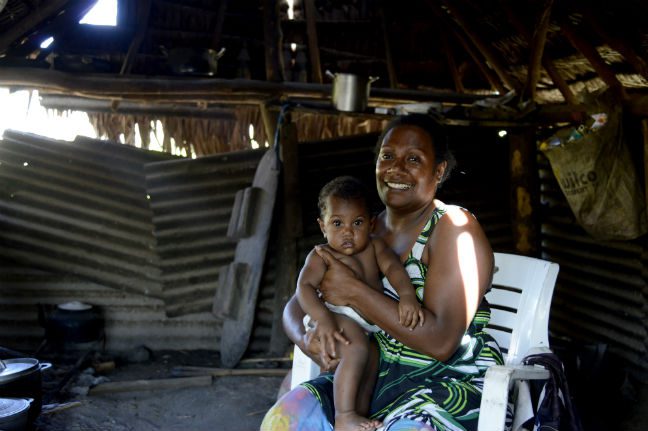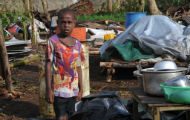
By Amy Christian, Oxfam Communications Coordinator
It was on Monday 23 March when the first Vanuatu ferry loaded its cargo of much-needed aid for some of the northern and most remote islands of Vanuatu. Oxfam had 400 hygiene kits on board ready to give to the worst affected communities on Ambrym Island.
The people started running down the hill to greet us. “We heard you were coming on the radio this morning,” they told us, their excitement and relief palpable. “You’re the first people to come here since the cyclone.”
It was 6pm and the sun had set as we boarded the ferry and started our journey. We were due to arrive at Ambrym Island at 6am on Tuesday, approximately 12 hours later. We didn’t know it then but the journey would in fact take us over 30 long hours. We watched the sun set, rise, and set once again from the deck of the ferry, counting the hours and revising plans as we travelled slowly along.
As we neared Ambrym Island in the early hours of Wednesday morning, we watched the live volcanoes light up the dark skies, the smoke and ash mingling with the night clouds. Not long after, the ferry anchored at sea and we unloaded our cargo onto a small barge boat that took us to the shore, towards a gathering of local fishermen who had come to help.
After a quick sleep, we set off from Craig’s Cove in west Ambrym in four speedboats loaded with Oxfam’s hygiene kits. It took us another two hours to reach the east side of the island and the community of Utas, who we knew had been badly affected by Cyclone Pam almost a week before.
In the daylight we could see Ambrym Island in all its beauty: rich black volcanic earth and sand, crystal clear waters, and thousands of acres of lush green trees, now broken, bare and torn apart.
We didn’t know what to expect when we reached Utas. Our visit was to distribute hygiene kits to the most affected families in the east but also to carry out a much-needed assessment of people’s needs since the cyclone hit.
As the boats came round the east point of the island, we could see people walking along the beach and others snorkeling for fish in the shallow water. When they spotted us, the people started running towards us and shaking our hands, thanking us for coming.
It’s hard to describe how that moment felt — everyone greeted us with such relief and hope. They knew that we had come there to help them. The atmosphere was electric.
Utas sits on a cliff edge, up a steep and precarious hill. As we came to the top of the climb, the first thing we saw was flattened and damaged homes everywhere. It was instantly clear that this community had been hit very hard by Cyclone Pam.
It took no time at all to unload the hygiene kits. The community made a line down the steep hill and passed them out one-by-one until they were all at the top.
Jenny
I met Jenny who took me for a walk around the village and to see her home. “We have never seen a cyclone like this one,” she told me. “There was one a long time ago but it wasn’t as bad as this one.
“All of our houses have blown down. We are sleeping in the church now. You can see my house has been flattened by the cyclone. Our wells are contaminated now so we can’t drink that water. We saved some in a tank, which is okay, but by next week, it will run out. Our crops were ruined and you can see the fruit, like bananas, was blown down and now it’s rotting in this heat.
You are the first ones to come here. We are so happy you came; we have been waiting for help.
Jenny showed me her home which now had no walls or roof. She was sleeping in a small tent inside what was left of the house she once had. She told me it had been a tough week and she was worrying about a lot of things. “We haven’t seen anyone for a week, since the night of the cyclone. You are the first ones to come here. We are so happy you came; we have been waiting for help.”
Back at the community hall, plans were being made with the local chiefs of east Ambrym to distribute the hygiene kits to the most affected families. They told a very similar story to Jenny — homes were badly damaged, and water tanks and gardens too, meaning people’s water supply was contaminated and they had very little food to eat.
Leanne
Later I met Leanne (pictured). Originally from Ambrym Island, she had moved to Port Vila with her parents but had recently returned to teach primary school. She recounted the hours leading up to the cyclone and told me how scared she had been when the storm finally arrived.
“We heard the cyclone was coming on Wednesday. We closed the school and sent the children back to their houses. Everybody started packing everything up and moved to the church with as much as we could carry. We live in traditional housing here and they can’t withstand a cyclone.
“We were waiting in the church but nothing happened … It wasn’t until Friday that it started raining hard. The trees started blowing and all the village went to the church. At 2pm it started.
“It was very scary; we could hear things flying around. At 6pm, we were in the church and we could hear the house next door to us fall down. The wind was very, very strong. We could hear things breaking but we couldn’t see anything because we’d blocked all of the windows.
“Everyone was very scared because the church was the last place we could go; there were no more houses to run to. If the church roof came off, that would be it.
“On Thursday night, just before the hurricane started, a baby was born in the clinic. During the cyclone, the roof blew off the clinic and the baby and her mother were inside. We could hear the woman screaming.
During the cyclone, the roof blew off the clinic and the baby and her mother were inside. We could hear the woman screaming.
“Some of the men left the church and went to the clinic to help her. They fetched her and brought her to the church. We could hear people outside — they were banging on the door and when we opened it, they bought in the new baby.
“Just after that, the back of the church came off and then five of the iron roofing sheets came flying off too. It was terrifying. I was very scared. I started crying. I couldn’t imagine being in such a situation.
“After that, we could hear all of the houses blowing away and all the ladies were crying. We were worried about where we were going to sleep after it all stopped.
“The water was rushing in through the door. I was very scared. I just kept imagining what would happen to us if it lasted all night.
“The men made long ropes with towels and sheets, and tied them to the roof panels. When the wind blew hard, they all pulled down to keep the roof on. We didn’t sleep that night.
“The wind started to go down at about four or five in the morning. It was still blowing but not that strong, and it was still raining but people came outside anyway. They wanted to see what had happened to their homes.
“When people saw their homes that morning they started to cry. People don’t know what they’re going to do.”
As Leanne told me her story, some of the other women gathered round and murmured sounds of agreement. It was clear that Cyclone Pam had really shaken the families living in Utas.
Leanne went on to tell me how worried she was about the next few months and how the community would cope in the aftermath of the cyclone. “What people need is water and medical help. In not too long, we will have children with diarrhoea because of the unsafe drinking water.
“There are 83 people in this village who depend on their gardens. Now their gardens are destroyed. It won’t be long until there’s a problem.
“In one or two months, the gardens will start to look good again but it will take three months before we can harvest anything. What are we going to eat whilst we wait?”
As we left Ambrym the next morning, I waved goodbye to Leanne, Jenny and all the other families who had welcomed us into their village the day before. We left knowing that our Oxfam colleagues would be back very soon to help them through the next few months as they begin to rebuild the homes, gardens and lives Cyclone Pam had done its best to destroy.
Although people had lost so much in Utas, the feeling in the community was one of hope. Everywhere we saw homes being rebuilt, damaged trees and bits of houses being swept up and cleared away. I have no doubt that when I return to Ambrym one day that the people will have built back their lives stronger than before.
You can help provide emergency relief to families affected by Cyclone Pam. Please give generously.
